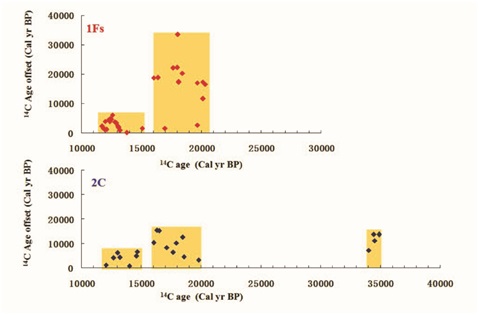The old carbon effect is very troublesome in the study of 14C chronologies in lakes from arid regions. However, the anomalous signal input of the old carbon may provide good insight for paleoclimatic change. Recently, based on the research of reliable 14C chronology in Qinghai Lake, Prof. ZHOU Weijian, in the Institute of Earth Environment, Chinese Academy of Sciences, found striking pulses of relatively old organic radiocarbon, resulting from a set of distinct meltwater events recorded at 35, 19 and 14 ka (ZHOU et al., 2016Quaternary Science Reviews). When the glaciers melted, relatively old organic carbon was released into the lake and these events were observed to be superimposed on both chronologies. Therefore, the anomalous old radiocarbon data can be used as a paleoclimatic proxy that responds to glacial melting. Furthermore, Prof. ZHOU suggested in the future study of 14C chronologies, anomalous old radiocarbon data shall not be taken for granted, and rather its causes deserve more consideration.
Since 2006, Prof. ZHOU weijian has been working on the old carbon correction, and put forward method of a piecewise linear regression in which lithological changes in the profile was taken into account to correct the old carbon in lakes. With the help of this method, the 14C chronostratigraphy has been successfully reconstructed in Qinghai Lake (An et al., 2012Scientific Report; Zhou et al., 2014Radiocarbon).

Fig.1 The comparison of the core 2C record with other climatic records. (a) July 65°N insolation (Berger and Loutre, 1991); (b) Dongge and Hulu cave speleothem δ18O records (Dykoski et al., 2005; Wang et al., 2008); (c) 2C core total organic carbon (TOC); (d) core 2C flux of the >25 mm grain size fraction (It may regarded as westerlies climate proxy); (e) NGRIP ice core δ18O (Rasmussen et al., 2006). The numbers 1-7 represent the Dansgaard/Oeschger (D/O) events. The yellow columns represent the Henrich (H) events 1-4. The blue columns represent our anomalous old carbon events 1-3. (Image by ZHOU, et al)

Fig.2. Age departure of anomalous 14C dates from the radiocarbon age model baseline. An interesting observation from our results is that they suggest this process took about 4 ka to complete following the 19 ka cal BP deglaciation, and about 3 ka following the 14 ka cal BP deglaciation. The data are too sparse to estimate the time involved in the ~35 ka cal BP deglaciation. (Image by ZHOU, et al)
Contact: ZHOU Weijian, State Key Laboratory of Loess and Quaternary Geology, Institute of Earth Environment, Chinese Academy of Sciences, Xi’an 710061, China
 © 2015 Institute of Earth Environment,CAS
© 2015 Institute of Earth Environment,CAS Address:No. 97 Yanxiang Road, Xi'an 710061, Shaanxi, China

 Location :
Location :